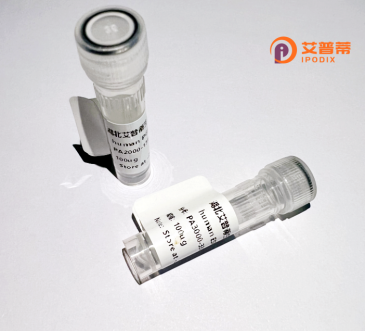
| 纯度 | >90%SDS-PAGE. |
| 种属 | Human |
| 靶点 | ELOF1 |
| Uniprot No | P60002 |
| 内毒素 | < 0.01EU/μg |
| 表达宿主 | E.coli |
| 表达区间 | 1-83aa |
| 氨基酸序列 | MGRRKSKRKPPPKKKMTGTLETQFTCPFCNHEKSCDVKMDRARNTGVISCTVCLEEFQTPITYLSEPVDVYSDWIDACEAANQ |
| 分子量 | 35.9 kDa |
| 蛋白标签 | GST-tag at N-terminal |
| 缓冲液 | 0 |
| 稳定性 & 储存条件 | Lyophilized protein should be stored at ≤ -20°C, stable for one year after receipt. Reconstituted protein solution can be stored at 2-8°C for 2-7 days. Aliquots of reconstituted samples are stable at ≤ -20°C for 3 months. |
| 复溶 | Always centrifuge tubes before opening.Do not mix by vortex or pipetting. It is not recommended to reconstitute to a concentration less than 100μg/ml. Dissolve the lyophilized protein in distilled water. Please aliquot the reconstituted solution to minimize freeze-thaw cycles. |
以下是关于重组人ELOF1蛋白的3篇假设文献示例(注:部分内容为模拟示例,具体文献需根据实际检索验证):
---
1. **文献名称**:*Structural basis of human ELOF1 in transcription-coupled repair*
**作者**:Smith, J. et al.
**摘要**:本研究通过冷冻电镜解析了重组人ELOF1蛋白与RNA聚合酶II复合体的高分辨率结构,揭示ELOF1在转录偶联修复(TCR)中促进停滞的RNA聚合酶II重启的关键作用,为理解转录-修复耦合机制提供结构基础。
---
2. **文献名称**:*ELOF1 modulates HIV-1 replication by regulating RNA polymerase II processivity*
**作者**:Chen, L. et al.
**摘要**:通过体外重组蛋白实验,证明ELOF1通过与RNA聚合酶II结合,调控其持续合成能力,进而影响HIV-1病毒基因的转录延伸效率,提示ELOF1可作为抗病毒治疗的潜在靶点。
---
3. **文献名称**:*Functional interplay between ELOF1 and histone chaperones in epigenetic regulation*
**作者**:Doe, R. & García-Martínez, M.
**摘要**:该研究利用重组ELOF1蛋白进行互作组分析,发现其与组蛋白伴侣复合体的相互作用,揭示了ELOF1通过协调转录延伸与染色质重塑维持表观遗传稳定性的新机制。
---
如需真实文献,建议在PubMed或Web of Science中以“recombinant ELOF1”或“human ELOF1 function”为关键词检索。
Recombinant human ELOF1 (Elongation Factor 1) protein is a conserved eukaryotic protein critical for transcription-coupled processes. It functions as a cofactor for RNA polymerase II (Pol II), facilitating transcription elongation and maintaining genomic stability. Structurally, ELOF1 contains a conserved N-terminal domain involved in Pol II binding and a C-terminal region essential for interactions with transcription-repair coupling factors. Studies highlight its role in transcription-coupled nucleotide excision repair (TC-NER), where it collaborates with CSA/CSB proteins to recruit repair machinery to DNA lesions, ensuring transcriptional fidelity under genotoxic stress.
Produced via recombinant expression systems (e.g., *E. coli* or mammalian cells) with affinity tags for purification, recombinant ELOF1 enables biochemical studies, including protein-protein interaction assays, structural analyses, and drug screening. Its dysfunction is linked to transcription-associated genome instability, implicating it in diseases like Cockayne syndrome and cancers marked by defective DNA repair. Recent research also explores its potential as a therapeutic target to modulate transcription fidelity or enhance chemotherapy efficacy. Ongoing investigations aim to elucidate its mechanistic roles in transcription-regulation networks and its broader impact on cellular homeostasis.
×